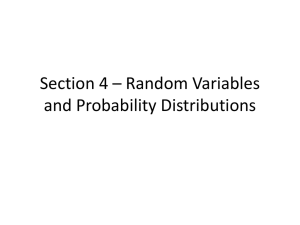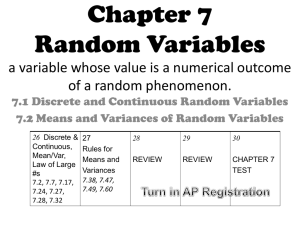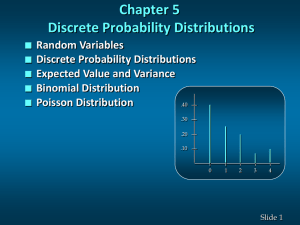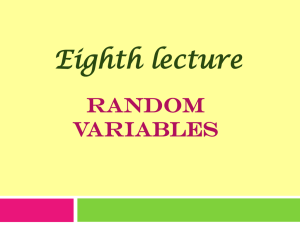4.1 Probability Distributions
advertisement
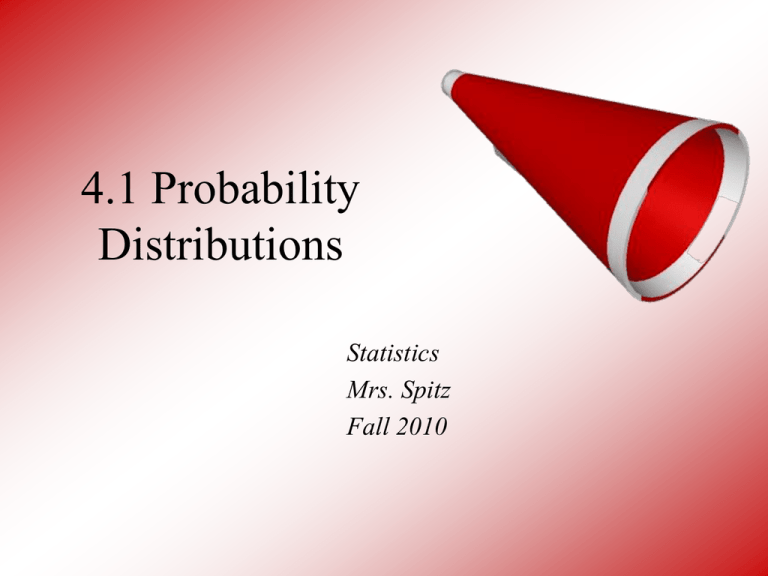
4.1 Probability
Distributions
Statistics
Mrs. Spitz
Fall 2010
Objectives/Assignment
• How to distinguish between discrete random variables and
continuous random variables
• How to construct a discrete probability distribution and its
graph
• How to determine if a distribution is a probability
distribution
• How to find the mean, variance, and standard deviation of
a discrete probability distribution
• How to find the expected value of a probability distribution
• Assignment pp. 159-162 #1-30 all
Random Variables
• The outcome of a probability experiment is often a
count or a measure. When this occurs, the
outcome is called a random variable.
• A random variable, x, represents a numerical value
assigned to an outcome of a probability
experiment.
• There are two types: discrete and continuous
Discrete v. continuous
• A random variable is discrete if it has a
finite or countable number of possible
outcomes that can be listed.
• A random variable is continuous if it has an
infinite number of possible outcomes
represented by an interval on the number
line.
So . . .
• Suppose you conduct an experiment of the
number of calls a salesperson makes in one day.
The possible values of the random variable are
0, 1, 2, 3, 4, and so on. Because the set of
possible outcomes {0, 1, 2, 3 . . . } can be listed,
x is a discrete random variable. You can
represent its values as points on a number line.
...
0
1
2
3
4
5
6
7
8
x can only have whole
number values 0, 1, 2, 3 . . .
So . . .
• A different way to conduct the study would be to
measure the time (in hours) a salesperson
spends making calls in one day. Because the
time spent making sales calls can be any
number from 0 to 24 (including fractions and
decimals), x is a continuous random variable.
You can represent its values with an interval on
a number line, but you cannot list all the possible
values.
0
3
6
9
12
15 18 21 24
x can have any value
between 0 and 24
Ex. 1: Discrete variables and
continuous variables.
• Decide whether the random variable, x, is
discrete or continuous. Explain your reasoning.
1. x represents the number of stocks in the Dow
Jones Industrial Average that have share price
increases on a given day.
The number of stocks whose share value
increases can be counted {0, 1, 2, 3 . . . }. So x
is a discrete random variable.
Ex. 1: Discrete variables and
continuous variables.
• Decide whether the random variable, x, is
discrete or continuous. Explain your
reasoning.
2. x represents the volume of bottled water
in a 32-ounce container.
The amount of water in the container can be
any volume between 0 and 32, so x is a
continuous random variable.
Note:
• It is important that you can distinguish
between discrete and continuous variables
because different statistical techniques are
used to analyze each. The remainder of this
chapter focuses on discrete random
variables and their probability distributions.
You will study continuous distributions
later.
Discrete Probability Distributions
• Each value of a discrete random variable can be
assigned a probability. By listing each value of the
random variable with its corresponding probability, you
are forming a probability distribution.
1. The probability of each value of the discrete random
variable is between 0 and 1 inclusive. That is,
0 P(x) 1
2. The sum of all the probabilities is 1. That is,
P(x) = 1
Graphing
• Because probabilities represent relative
frequencies, a discrete probability
distribution can be graphed with a relative
frequency histogram.
Guidelines of Constructing
a Discrete Probability
Distribution
Let x be a discrete random variable with possible
outcomes x1, x2, . . . xn.
1. Make a frequency distribution for the possible
outcomes.
2. Find the sum of the frequencies.
3. Find the probability of each possible outcome by
dividing the frequency by the sum of the
frequencies.
4. Check that each probability is between 0 and 1
and that the sum is 1.
Ex. 2: Constructing a Discrete
Probability Distribution
• An industrial psychologist has administered a
personality inventory test for passive-aggressive
traits to 150 employees. Individuals were rated
on a score from 1 to 5 where 1 was extremely
passive and 5 extremely aggressive. A score of
3 indicated neither trait. The results are shown
on the next slide. Construct a probability
distribution for the random variable, x. Then
graph the distribution.
Solution
Score (x)
Frequency (f)
1
24
2
33
3
42
4
30
5
21
Divide the frequency of
each score by the total
number of scores (150) to
find the probability for
each value of the random
variable.
P(1) = 24/150 = 0.16
P(2) = 33/150 = 0.22
P(3) = 42/150 = 0.28
P(4) = 30/150 = 0.2
P(5) = 21/150 = 0.14
• The discrete
probability
distribution is shown
in the following
table. Note that
each probability is
between 0 and 1
and the sum of the
probabilities is 1.
• The relative
frequency
distribution is also
shown at the right.
The area of each
bar represents the
probability of a
particular outcome.
x
1
2
3
4
5
P(x)
0.16
0.22
0.28
0.2
0.14
0.3
0.25
0.2
0.15
RF
0.1
0.05
0
1
2
3
4
5
Ex. 3: Verifying Probability
Distributions
• Verify that the
distribution is a
probability
distribution.
Solution: If the distribution
is a probability
distribution, the (1) each
of probability is between
0 and 1, inclusive and (2)
the sum of the
probabilities equals 1.
Days of Rain
Probability
0
0.216
1
0.432
2
0.288
3
0.064
Ex. 3: Verifying Probability
Distributions
1. Each probability is
between 0 and 1.
2. P(x) = 0.216 + 0.432 +
0.288 + 0.064 = 1
Because both conditions are
met, the distribution is a
probability distribution.
Days of Rain
Probability
0
0.216
1
0.432
2
0.288
3
0.064
Ex. 4: Probability Distributions
• Decide whether each distribution is a probability
distribution.
x
5
6
7
8
P(x)
0.28
0.21
0.43
0.15
Each probability is
between 0 and 1.
However, the sum of
the probabilities is
1.07, which is greater
than 1. So, it is NOT
a probability
distribution.
Ex. 4: Probability Distributions
• Decide whether each distribution is a probability
distribution.
x
1
2
3
4
P(x)
½
¼
5/4
-1
The sum of the
probabilities is equal
to 1.
However, P(3) and
P(4) are not between
0 and 1. So, it is NOT
a probability
distribution.
Mean, Variance and Standard
Deviation
• You can measure the central tendency of a
probability distribution with its mean, and measure
the variability with its variance and standard
deviation.
The mean of a discrete random variable is given by:
= xP(x).
Each value of x is multiplied by its corresponding
probability and the products are added.
Note:
• The mean of the random variable represents
the “theoretical average” of a probability
experiment and sometimes is not a possible
outcome. If the experiment were performed
thousands of times, the mean of all the
outcomes would be close to the mean of the
random variable.
Ex. 5: Finding the Mean of a Probability
Distribution
The probability
distribution for the
personality inventory
test for passiveaggressive traits
discussed in Ex. 2 is
given at the right.
Find the mean score.
What can you
conclude?
x
P(x)
1
0.16
2
0.22
3
0.28
4
0.20
5
0.14
Organize your tables carefully.
x
P(x)
xP(x)
1
0.16
1(0.16) = 0.16
2
0.22
2(0.22) = 0.44
3
0.28
3(0.28) = 0.84
4
0.20
4(0.20) = 0.80
5
0.14
5(0.14) = 0.70
P(x) = 1 xP(x) = 2.94
• Use the table to organize
your work as shown at
the left. From the table,
you can see that the
mean is 2.94. A score of
3 represents an individual
who is neither extremely
passive nor aggressive,
but is slightly closer to
passive.
MEAN
Note:
• While the mean of the random variable of a
probability distribution describes a typical
outcome, it gives no information about how
the outcomes vary. To study the variation of
the outcomes, you can use the variance and
standard deviation of the random variable of
a probability distribution.
Standard Deviation of a Discrete Random
Variable
• The variance of a discrete random
variable is:
2 = (x - )2P(x)
The standard deviation is:
= √2
Ex. 6: Finding the variance and Standard
Deviation
• The probability
distribution for the
personality inventory
test for passiveaggressive traits
discussed in Ex. 2 is
given at the right.
Find the variance and
standard deviation of
the probability
distribution.
x
P(x)
1
0.16
2
0.22
3
0.28
4
0.20
5
0.14
You know from ex. 5 that the mean of the distribution is = 2.94. Use a table
like the one below to organize your work!
P(x)
x-
1
0.16
1 – 2.94 =
-1.94
(-1.94)2 = (0.16)(3.764) = 0.602
3.764
2
0.22
2 – 2.94 =
- 0.94
(-0.94)2 = (0.22)(0.884) = 0.194
0.884
3
0.28
3 – 2.94 =
0.06
(0.06)2 =
0.004
(0.28)(0.004) = 0.001
4
0.20
4 – 2.94 =
1.06
(1.06)2 =
1.124
(0.20)(1.124) = 0.225
0.14
5 – 2.94 =
2.06
(2.06)2 =
4.244
(0.14)(4.244) = 0.594
x
5
P(x) = 1
(x -)2
P(x)(x - )2
P(x)(x - )2 = 1.616 =
VARIANCE
• So, the variance of 2 = 1.616 and the
standard deviation is
= √1.62 ≈1.27
Lots of steps, so organize your work
carefully. Most of you got the problems
correct, but some missed the details.
Expected Value
• The expected value of a discrete random
variable is equal to the mean of the
random variable.
Expected value = E(x) = = xP(x)
Ex. 7: Finding an Expected Value
• At a raffle, 1500 tickets are sold at $2 each
for four prizes of $500, $250, $150 and
$75. You buy one ticket. What is the
expected value of your gain?
• Note: Expected value plays a role in
decision theory. Although probability can
never be negative, the expected value can
be negative.
SOLUTION: To find the gain for each prize, subtract the
price of the ticket from the prize. For instance, your gain for
the $500 prize is $500 - $2 = $498. Then write a probability
distribution for the possible gains (or outcomes).
Gain, x
$498
$248
$148
$73
- $2
Probability
, P(x)
1/1500
1/1500
1/1500
1/1500
1496/
1500
Then, using the probability distribution, you can find the
expected value. E(x) = xP(x)
E(x) xP( x)
1
1
1
1
1496
498
248
148
73
(2)
1500
1500
1500
1500
1500
$1.35
Because the expected value is negative, you can expect
to lose an average of $1.35 for each ticket you buy.

